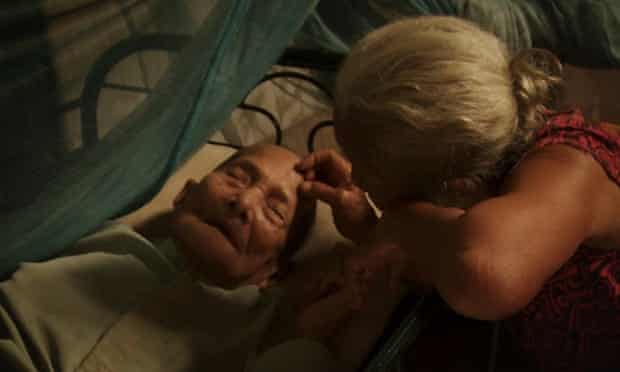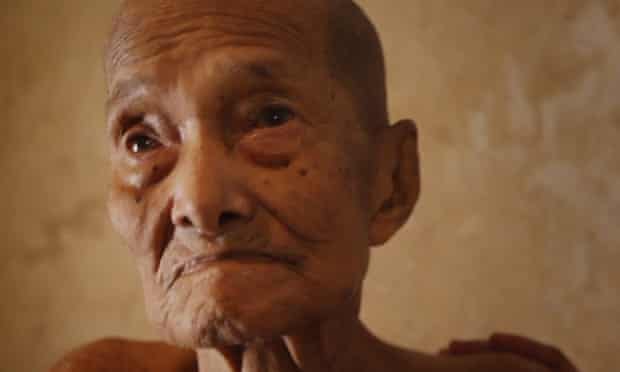To See Die Again the Act of Filming and the Act of Killing
J oshua Oppenheimer's The Look of Silence is a stunning companion slice, or mayhap narrative development, to that boggling 2012 documentary The Human action Of Killing. Its enigmatic championship may bespeak the numb silence which is the but mayhap reaction to a certain kind of savagery and inhumanity, but perhaps mean the way that a nation sees but not see, sees in such a selective and slanted manner as to suppress meaning, sees in such a way every bit to smother dissent into silence.
The Act of Killing showed Oppenheimer tracking down the grinning, ageing members of the Indonesian civilian militia who with the tacit approval of the regular army and government carried out the wholesale slaughter of a million suspected communists after the 1965 Suharto coup; sensationally, Oppenheimer persuaded them to re-act their crimes in the styles of their favourite movies.
This technique — a veritable Marat/Sade of 20th-century history — exposed the nature of the offence more effectively than traditional documentary procedure. It revealed that the barbarity was not merely an deed of ideological brutality, but grouping dysfunction, a convulsion of mass psychosis, and that the perpetrators were moreover entirely unrepentant. Indeed, the thought of submitting their acts to some kind of upstanding assessment or justification had never occurred to them. Oppenheimer has a claim to have made a sort of history with that pic.
This new movie is far more conventional, and conventionally confrontational than the previous 1, and the people involved seem at last to have grasped how horrendous they are appearing and and so there is more of the familiar embattled-interviewee choreography: the demands to stop filming, the shrill addresses to the manager "Josh" behind the camera, and the removal of the radio microphone.
Only this film is just as piercingly and authentically horrifying equally before. It is filmed with exactly the same superb visual sense, the same passionate dear of the Indonesian mural, and dialogue exchanges are captured with the same chilling crispness.
The person at its centre is Adi, an opthalmologist in his early 40s who travels around making housecalls, plumbing fixtures people for spectacles — and so the imagery of seeing and willed myopia is established from the outset. Adi's brother Ramli was killed past the militia just before Adi was born, a fiddling criminal who was dragged out of prison along with hundreds of others and slaughtered and then that the militia could boost their ain version of a "bodycount" a righteous tally of supposed communist-slayings. Ramli was butchered in various sickening ways which the perpetrators chillingly boast about.

Oppenheimer has the killers on video tape doing merely that — he appears to accept discovered these stomach-turning characters around 10 years ago, while researching The Act of Killing. We see Adi impassively watching their giggling performance on boob tube, and then going effectually to interview the killers, in some cases fitting them with spectacles, in interview situations set up by Oppenheimer. Incredibly, "Josh" is all the same not especially suspected or loathed by these villains, and they are of form utterly indifferent to his movie and how it has been received.
With great calm and dignity, Adi sets out the facts, and so he — and we — have to listen to expert deal of sub-Nuremberg bluster about obeying orders, or a sort of introspective silence, perhaps indicating the glimmerings of conscience or a strategic retreat into Alzheimer's. But often there is the same cackle that this was something that needed to be done.
We go ane macabre particular. Many of them seemed to believe that drinking the blood of their victims would forbid them from going mad. Just as Tom Lehrer believed that Kissinger's Nobel Peace Prize rendered satire obsolete, so this claret-drinking particular renders futile any kind of political or psychological analysis. It is pure reactionary-murderous voodoo, and it does appear to be believed past people who, perhaps, deep in their heart, recognised that they had already gone mad. And what is even so more painful is that Adi finds that his now 82-year-quondam uncle was a prison baby-sit who colluded in the killings.

The actress stratum of heartbreak in Adi'southward life is his parents: they had him in tardily center-age when Ramli was killed, and seemed to regard his nativity as some kind of providential divine gesture of comfort. But now his mother and male parent are extremely old, over 100, his male parent blind (that epitome again) and wizened, and his poor stooped female parent defended to looking afterwards this tiny petty creature. It is as if they are cursed never to die, a terrible Struldbrugian existence. The horror they have gone through lives interminably on.
After The Act of Killing, Oppenheimer was criticised in some quarters for sensationalism and exploitation and it is conceivable that his unsparing view of Adi's badly unhappy parents will betrayal this director to more objections on this score. For me, the film about Adi, his parents and his homeland has a tragic dimension, and it is obvious that he has notwithstanding but scratched the surface. The Look of Silence — like The Act of Killing — is absorbing and important film-making.
News: Oppenheimer and Rukun speak at the Venice press conference
More on The Act of Killing
Source: https://www.theguardian.com/film/2014/aug/27/the-look-of-silence-review-act-of-killing-venice-film-festival
0 Response to "To See Die Again the Act of Filming and the Act of Killing"
Post a Comment